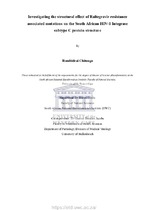| dc.description.abstract | Background and Aims Human Immunodeficiency Virus (HIV) type 1 group M subtype C (HIV-1C) accounts for nearly half of global HIV-1 infections, with South Africa (SA) being one of the countries with the highest infection burden. In recent years, SA has made great strides in tackling its HIV epidemic, resulting in the country being recognized globally as the one sub-Saharan country with the largest combination antiretroviral therapy (cART) programme. Regardless of the potency of cART, the efficacy of the treatment is limited and hampered by the emergence of drug resistance. The majority of research on HIV-1 infections, effect of antiretroviral (ARV) drugs and understanding resistance to ARV drugs has been extensively conducted, but mainly on HIV-1 subtype B (HIV-1B), with less information known about HIV-1C. HIV-1’s viral Integrase (IN) enzyme has become a viable target for highly specific cART, due to its importance in the infection and replication cycle of the virus. The lack of a complete HIV-1C IN protein structure has negatively impacted the progress on structural studies of nucleoprotein reaction intermediates. The mechanism of HIV-1 viral DNA’s integration has been studied extensively at biochemical and cellular levels, but not at a molecular level. This study aims to use in silico methods that involve molecular modeling and molecular dynamic (MD) simulations to prioritize mutations that could affect HIV-1C IN binding to DNA and the IN strand-transfer inhibitor (INSTI) dolutegravir (DTG). The purpose is to help tailor more effective personalized treatment options for patients living with HIV in SA. This study will in part use patient derived sequence data to identify mutations and model them into the protein structure to understand their impact on the HIV-1C IN protein structure folding and dynamics. Methods Our sample cohort consisted of 11 sample sequences derived from SA HIV-1 treatmentexperienced
patients who were being treated with the INSTI raltegravir (RAL). The sequences were submitted to the Stanford HIV resistance database (HIVdb) to screen for any new/novel variants resulting from possible RAL failure. Some of these new variants were analyzed to analyse their effect, if any, on the binding of DTG to the HIV-1C IN protein. Additionally, an HIV-1C IN consensus sequence constructed from SA’s HIV-1 infected population was used to model a complete three-dimensional wild type (WT) HIV-1C IN homology model. All samples were sequenced by our collaborators at the Division of Medical Virology, Stellenbosch University together with the National Health Laboratory Services (NHLS), SA. The HIV-1CZA WT-IN protein enzyme was predicted using SWISS-MODEL, and the quality of the resulting model validated. Various analyses were conducted in order to study and assess the effect of the selected new variants on the protein structure and binding of DTG to the IN protein. The mutation Cutoff Scanning Matrix (mCSM) program was used to predict protein stability after mutation, while PyMol helped to study any changes in polar contact activity before and after mutation. PyMol was also used to generate four mutant HIV-1C IN complex structures and these structures together with the WT IN were subjected to production MD simulations for 150 nanoseconds (ns). Trajectory analyses of the MD simulations were also conducted and reported. Results A total of 21 new variants were detected in our sample cohort, from which only six were chosen for further analyses within the study. A homology model of HIV-1C IN was
successfully constructed and validated. The structural quality assessment indicated high reliability of the HIV-1C IN tetrameric structure, with more than 90.0% confidence in modelled regions. Of the six selected variants, only one (S119P) was calculated to be slightly stabilizing to the protein structure, with the other five found to be destabilizing to the IN protein structure. Variant S119P showed a loss in polar contacts that could destabilize the protein structure, while variant Y143R, resulted in the gain of polar contacts which could reduce flexibility of the 140’s region affecting drug binding. Similarly, mutant systems P3 (S119P, Y143R) and P4 (V150A, M154I) showed reduced hydrogen bond formation and the weakest non-bonded pairwise interaction energy. These two systems, P3 and P4, also showed significantly reduced to none polar contacts between DTG, magnesium (MG) ions and the IN protein, compared to the WT IN and P2 mutant IN systems. Interestingly, the WT structure and systems P1 (I113V) and P2 (L63I, V75M, Y143R) showed the highest non-bonded interaction energy, compared to systems P3 and P4. This was further supported by the polar interaction analyses of simulation clusters from the WT IN and mutant IN system P2 (L63I, V75M, Y143R), which were the only protein structures that formed polar contacts with DTG, MG ions and DDE motif residues, while P1 only made contacts with DNA and IN residues. Conclusion Findings from this study leads to a conclusion that double mutants (S119P, Y143R) and (V150A, M154I) may result in a reduction in the efficacy of DTG, especially when in combination. Furthermore, variants identified in systems P1 and P2 may still allow for effective DTG binding to IN and outcompete viral DNA for host DNA to prevent strand transfer. To the best of our knowledge, this is the first study that uses the consensus WT HIV1C IN sequence to build an accurate 3D homology model to understand the effect of less frequently detected/reported variants on DTG binding in a South African context.
https://etd. | en_US |

